| Construction Rating: | starstarstarstarstar_border |
| Flight Rating: | starstarstarstarstar_border |
| Overall Rating: | starstarstarstarstar_border |
| Published: | 2012-04-16 |
| Manufacturer: | Quest  |
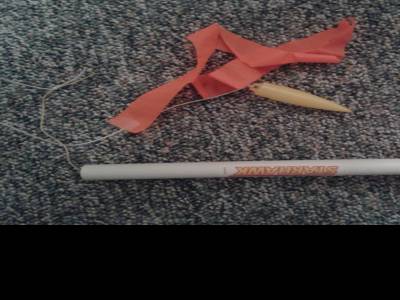 Brief
Brief
This is an easy-to-build rocket intended for groups. I'm comparing it to an Estes Generic E2x in this review.
Components
The name of the game is "simple-to-fly" with this rocket. Plastic fins, a launch lug that is already molded into the fin can, and a simple streamer recovery make this the most foolproof rocket I'll ever assemble.
Here you should be able to see the fin can with the built in launch lug evident:
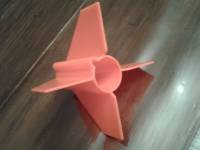
Here's the exploded view prior to construction. It has the Kevlar shock cord typical to Quest rockets, a motor mount (pre-cut for the engine hook!) and a simple sticker. The streamer comes with a plastic eyelet.
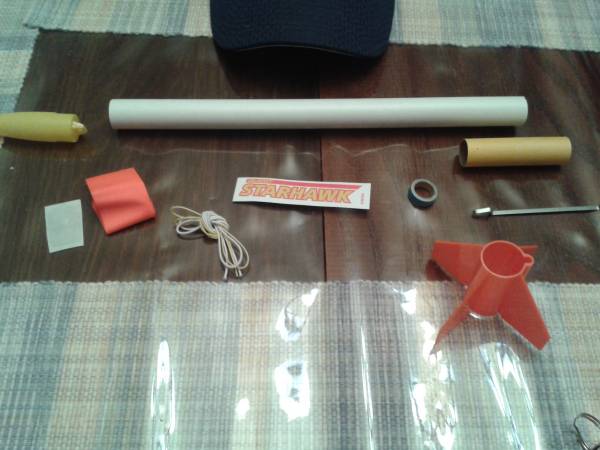
To give you an idea of the sizing, here is a Starhawk next to an Estes Generic E2x. Notice that the E2x employs a wider body tube, and comes with a launch lug that is glued to the rocket separately.
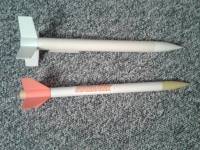
The E2x comes with a parachute and takes a little longer to assemble. Mind you, we still aren't talking hours, we're talking minutes.
Construction
This is meant to be a very easy rocket to assemble. In fact, they made it even easier than it used to be, and it was simple then. You jiterally just tie the shock cord to an engine ring, glue that in, mount an engine hook onto the engine mount, mount that into the body tube, then slip the fins over it. Finally, thread the shock cord through the body tube, then through the eyelet for the streamer, and tie it to the nosecone. In earlier kits you were supposed to carve a groove into one of the cardboard pieces with an Xacto knife, but that step is now gone with this model.
The launch lug and fins are plastic, and, therefore, foolproof which is good if you are relying on cub scouts or other young kids to build the rockets you are launching.
The only difficulty I had was the step where you thread the shock cord through the rocket (from the bottom to the top) after gluing in the engine mount. The body tube is too narrow to easily do this, especially if there's still wet glue in there from the previous step. I recommend making a long, but thin hook, out of a coat hanger so you can pull the cord through the tube.
Finishing
The finish can look a little cheap at times - it looks like a 5 dollar rocket - which it is. There's a picture here of the nose cone. You can see the molding was done somewhat quick and dirty. Mind you, I can find similar lines on the Estes E2x.

After you affix the sticker, I doubt you'll be overwhelmed by its beauty. Heck, the nose cone and the fin can colors don't even match!
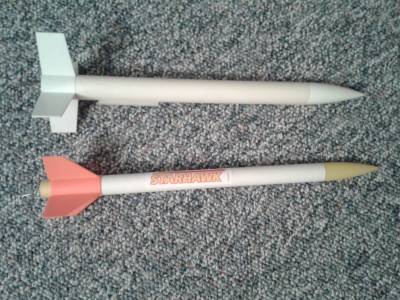
I'm not complaining, mind you. I took this as more evidence that this rocket is designed for one purpose: Inexpensive, easy construction for large groups.
Flight
I flew the StarHawk on an A8-3 and then on a C6-5. I am told that the C6-5 is not on the engine list and . . . temptation won out.
The A8-3 is perfect for those group launches in small fields. It climbs nicely and still feels like it's fast, doesn't get so high that you'd lose it. With the streamer, this thing fell fast. I got it to land within yards of the launch pad . . . in light wind, anyway.
The C6-5 is perfect for when you want to see a rocket climb, and climb, and climb. It will leave fast, carry the wind, and you MIGHT see it again.
Recovery
This rocket falls fast, which is what I am looking for with a group launch. Kids are really disappointed when their rockets don't come back within the treeline. I doubt the streamer is making it any slower.
Summary
Other Reviews
- Quest Starhawk By Matt Gillard
Brief: A 4FNC rocket designed for speed. I bought three of them on eBay. They came in a plastic bag without the usual card insert, so I have no idea what its color scheme is suppose to be. After visiting the Quest website, it seems that this rocket is from the education section and not intended for general sale. Construction: The parts list: motor clip blue thrust ring ...
- Quest Starhawk By Ken Johnson
An education-series rocket that can only be purchased in bulk. Perfect for a group of scouts, a school project, church groups, or someone who just wants a ton of the same rocket, for whatever reason. The individual kits come in a clear plastic bag, and contain a plastic nose cone molded in orange, a plastic fin assembly of the same color, a mylar launch lug, a length of Kevlar ® shock ...
 |
 |
Flights
Sponsored Ads
 |
 |











